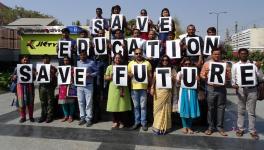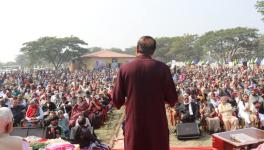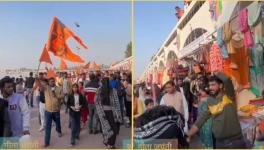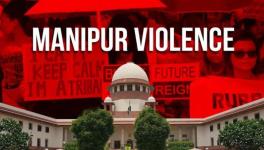Politics and Ramifications of the NRC in Assam
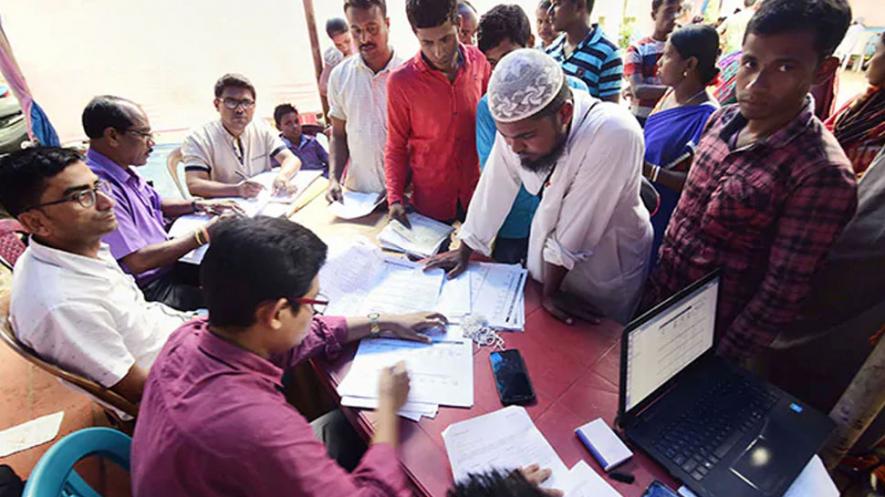
Image Courtesy: Zee News
The Northeastern state of Assam has never been the focus of national media in such a way before. In the last couple of years, the state has been hitting the head lines in all forms of media only for reason, the updating of the National Register of Citizens and its possible ramifications. The question of the ‘stateless’ people that it may create has been keenly watched by the international media as well.
Perhaps, now it needs no repetition that till now the NRC is unique and specific to Assam only. In independent India, only Assam had prepared an NRC in 1951. After independence in 1947, the country had its first census in 1951. In Assam, the data of the census was converted into the first NRC.
The Background: NRC, 1951
The migration which started during the Partition followed in the post-independence years too. Communist leader Hemen Das (89), who was witness to the post-independence communal tensions, recalls the situation immediately after independence, “After 1947, the western part of the country saw massive migration towards both sides of the border. The intensity of the migration slowed down significantly after 1948. The Constitution of India reflects this situation and provides for Indian citizenship who have come from Pakistan up to July 19, 1948. But in East Pakistan, there were massive riots post 1947. This led to large scale immigration to Assam, particularly in 1950. Also, there were large number of cases of arson and looting of Muslims of East Bengal origin in some parts of Assam. As a result, a considerable numbers of Muslims also fled to East Pakistan.”
He adds, “So in the immediate context of these migrations, the NRC in Assam was proposed in 1951 under the Census Act. Therefore, data of the census was converted to prepare the NRC in undivided Assam of post-independent India. Copies were sent to the police stations and the offices of Congress and Jamiat-Ulema-E-Hind. The NRC was supposed to be updated regularly, but it wasn’t.”
Also read: Assam Tense; Over 19 Lakh Names Excluded from NRC List
It may be mentioned here that the influx continued in post independent India, both due to economic and social reasons. Of course, there were fears of religious persecution in Islamic Pakistan and these factors also contributed to the influx. In 1971, East Pakistan was carved out of Pakistan and named as Bangladesh. The new country opted for a secular Constitution.
Assam Agitation
Then in 1979, a massive movement broke out in Assam which demanded detection and deportation of all those who have entered Assam from East Pakistan and Bangladesh. They demanded that 1951 should be the cut off year and NRC 1951, should be the basis. The Communist Party of India (Marxist) [CPI(M)] and other left and democratic forces opposed this demand and firmly expressed the view that March 25, 1971, should be the cut off date as Bangladesh would not be willing to take back pre-1971 migrants, i.e. of East Pakistan.
There were bloody attacks on CPI(M) and other left and democratic forces. But in the Assam Accord, signed between the All Assam Students’ Union (AASU)- All Assam Gana Sangram Parishad (AAGSP), the Assam government and the central government, as a culmination of the six year long Assam agitation on August 15, 1985, earmarked the cut off date as March 25, 1971, for detection and deportation of foreigners coming from Bangladesh. The Assam Accord was presented before Parliament on August 16 and subsequently, the Citizenship Act, 1955, was amended by inserting a new clause 6 (A). This clause provided for citizenship to all the immigrants from the ‘specified territory’. i.e. Bangladesh who have entered Assam and have generally been residing in the state upto March 24, 1971.
But the successive governments did nothing to detect the foreigners. On the contrary, indiscriminate harassment continued on thousands of religious and linguistic minorities in the name of foreigners. As the government failed to complete the barbed wire fencing in the border, an apprehension continued to haunt the psyche of the people of the state that influx is continuing unabated across the border. As a corollary, different assumptions and wild exaggerations about the number of infiltrators also continued.
In such a situation, an environment of suspicion guided many. A number of incidents occurred where people were harassed after being branded ‘Bangladeshi’. For members of the minority community, permanent resident certificate (PRC) became elusive. Consequently, for the students, admissions to the higher institutions, particularly the professional institutions became difficult.
Who are D-Voters
In 1996-97, the Election Commission of India (ECI) introduced the dangerous D-Voter (Doubtful Voter) system. ECI announced that on the basis of their enquiry, they have prepared a list of doubtful citizens and they would be stamped as D-voters in the electoral rolls. Later it became evident that a large number of people were stamped as D-voters without proper verifications. ECI ruled that only after they prove their Indian citizenship in the Foreigners’ Tribunals (FT) the ‘D’-label would be removed and they would get back their right to vote. This evoked sharp reactions and it was challenged in the court. But the Gauhati High Court and subsequently, the Supreme Court upheld the D-voter system.
Also read: Has the Search for Foreigners in Assam Ended?
Later, the procedure in the Foreigners Tribunals (FT) also changed fundamentally. Since 1983, the proceedings in the FTs were as per the Illegal Migrants (Detection by Tribunals) Act 1983 [IM(DT)]. As per this act, if a reference or complaint is made against a person (D-voter), the onus of proving rests on the accuser. But in the Sarbananda Sonowal vs. Union of India case, the Supreme Court struck down the IM(DT) Act on July 12, 2005. Since then, the proceedings in the FTs are as per the Foreigners Act, 1946, whereby the accused has to prove that he/she is not a foreigner.
Detention Camp
On January 3, 2013, a full bench of the Gauhati High Court ruled that ‘the persons detected to be foreigners shall be taken into custody and kept in detention camp (s) till they are deported from India within the aforesaid time-frame.’
These two D’s – detention camps and D-voters – have greatly impacted upon the happenings in Assam. Lakhs of people are stamped as D-voters. After 1997, it is not the ECI, but the Border Police that has prepared, in most of the cases arbitrarily, lists of suspected foreigners. Thereafter cases are referred to the FTs by the Superintendent of Police (Sps) of the Border Police. A copy of the list is forwarded to the Elector Registration officers (EROs) and they stamp these people as D-voters. In many cases, it is observed that the proceedings at the FTs are grievously faulty. As a result, many Indians are declared as foreigners and are being detained in detention camps.
In such a complex situation, the proposal for updating the NRC of 1951 slowly came into prominence. Assamese-speaking people and different tribal communities supported the proposal because they had an impression that an updated NRC would help detect the foreigners. The religious and linguistic minorities, too, supported the NRC because they hoped that it would release them from the agony of being declared as D-voter, detention camps and the related trauma. Almost all political parties and organisations supported the proposal for updating NRC with March 24, 1971, as the cut off date. The central government did agree for an updating of NRC way back in 2005, but postponed it again and again under different pretexts. Ultimately, the Supreme court intervened and the process started in 2013.
NRC Updating Process
According to the Citizenship (Register of Citizens and Issue of National Identity Cards) Rules, 2003, unlike the other parts of India, where it would be enumeration based, the NRC process in Assam would be application based. The three-month long application process, that ended on August 31, 2015, saw 68,37,660 applications (both offline and online) filed for 3,30,27,661 people. Fifteen documents were identified as admissible documents. People were asked to prove their legacy (i.e. presence in Assam or any other parts in India) before March 25, 1971, and the legacy person and his/her offsprings were eligible for NRC. Subsequently, the families were asked to submit their Family Trees. The names were verified for all the families who used the same legacy. Hearings were held where discrepancies were detected. Illiterate married women faced tremendous difficulties in establishing linkage with their fathers. Though Panchayat certificates were admissible documents, there were a number of riders along with it. Debate arose with the division of the applicants as original inhabitants (OI) and Non-original Inhabitants. Though there is provision for OI in Schedule to the Citizenship (Register of Citizens and Issue of National Identity Cards) Rules, 2003, on the basis of which the NRC is prepared, no parameters are prescribed for determining OI. So, the arbitrariness with which the NRC authority identified the OIs drew sharp flak.
Also read: Assam NRC Final List: Families Anxious, Worried as D-day Nears
The final NRC draft was published on July 30, 2018. A total of 40,43,948 (12.24%) applicants didn’t find place in the list. Then, started the phase of Claims and Objections. Out of 40,43,984 left out, 36,26,330 filed claims for inclusion and objections were raised against inclusion of 1,02,462 persons in the draft list. The NRC state coordinator proposed to drop five documents from admissible documents lists. But almost all political parties opposed it. Finally, the Supreme court overruled the proposal.
The Court asked the Union Home Ministry to propose the Standard Operating Procedure (SOP) for this phase. But the BJP government didn’t consult any political party or stake-holders for this. The CPI(M) Assam State Committee on its own proposed several important SOPs to the Home Ministry. One was, till the NRC process is over, the FTs dealing with the D-voters should be put ‘on hold’. All those who can prove their eligibility should be included in NRC. Names of those who are left out of the final list may be sent to the FTs for appeals etc. Another important suggestion was to include the names of women and children using the Family Tree mechanism. The Party also asked to go for DNA tests as a last resort to establish linkage with the legacy person, the cost of which should be borne by the government. But the BJP government, both at the centre and the state took the SOP most casually and sat upon the important suggestions.
Hearing in this phase was more rigorous, lakhs of people had to appear 4-5 times before the hearing panel in far off places. It involved costs almost unbearable for most families belonging to the lower economic groups. Again, objections were raised indiscriminately and in most of the occasions objectors were absent leading to ex-parte hearings.
On June 26, 2019, the NRC authority published an additional list whereby 1,02,462 people were proposed to be dropped from the Draft List as they were identified to be D-Voters (D-V), declared Foreigners (DF), people having cases pending at Foreigners Tribunals (PFT) etc. Separate hearings were arranged for these people.
Finally, after 4 long years the final list of NRC is published on August 31, 2019, which includes 3,11,21,004 (94.23%). A total of 19,06,657 (5.77%) names were excluded. It is quite clear that huge number of Indians have been left out. Even people having own legacy are not included. Large number of excludees are women. In a number of cases, children are out of the list even though their parents’ names are there. Some people have been excluded, even though using the same legacy, his/her brothers or sisters were found to be eligible for inclusion. Though the Refugee Certificates were admissible documents, in thousands of cases these were not accepted by the authorities. Thousands of Bengali Hindu people also submitted Migration Certificates. But these were not recognised as admissible documents.
Appeal : The Intricacies
Now, the excludees can file appeal in the designated Tribunals. The appeals have to be fielded within 120 days in the Foreigners Tribunals formed under the Foreigners Tribunal Order, 1964. The Tribunals will issue notice to the District Magistrates to submit the original file of the excludee within one month. After receiving these, within a month the Tribunal would decide whether the appeal has the merit to be heard. This is a dangerous provision by which a Tribunal can arbitrarily dismiss the appeal even without hearing it. The CPI(M) has already submitted a memorandum to the Union Home Secretary demanding scrapping of this provision.
Just on the eve of publishing of the NRC final list, the Central Government, through a extraordinary Gazette Notification on August 30, 2019 has further amended the provisions for appeal. According to this, if an appeal is rejected, then the tribunal should give a clear finding as to whether the appellant is a foreigner or not. This implies that if an appeal is rejected, the appellant will automatically be termed as a foreigner. This new provision may negatively impact upon the whole proceedings of the designated Tribunals.
Uncertainties ahead
After all legal options are exhausted, what will be the fate of the people left out? The government has been maintaining a stoic silence on this crucial issue. The issue has became critical because the representatives of the Bangladesh government are time and again denying the fact that there is any immigration from Bangladesh to India after 1971. Actually these type of statements are not based on facts. In the last 2 years, only 278 people have been accepted by the Bangladesh government who were detected to be foreigners coming from specified territories of late. On July 25, 25 persons who were in detention camps were handed over to Bangladesh Police at Sutarkandi border in Karimganj district by the India government.
Also read: NRC Final List: A Saga of Exclusion, Inclusion of ‘Genuine’ Indian Citizens
Anyway, if the Bangladesh government denies the people detected to be foreigners as their own citizens, then it is not possible to send them to Bangladesh. So, what is the solution of this issue involving lakhs of people? Detention camps can’t be the answer. A well thought out plan is necessary and every effort should be made to build up consensus. But, the government is not interested in a dialogue with anyone, even with the political parties. Communal politics and petty political interests are their driving force. If this continues, then the situation may get further complicated.
The writer is a state secretariat member of the Communist Party of India (Marxist). The views expressed are personal.
Get the latest reports & analysis with people's perspective on Protests, movements & deep analytical videos, discussions of the current affairs in your Telegram app. Subscribe to NewsClick's Telegram channel & get Real-Time updates on stories, as they get published on our website.









